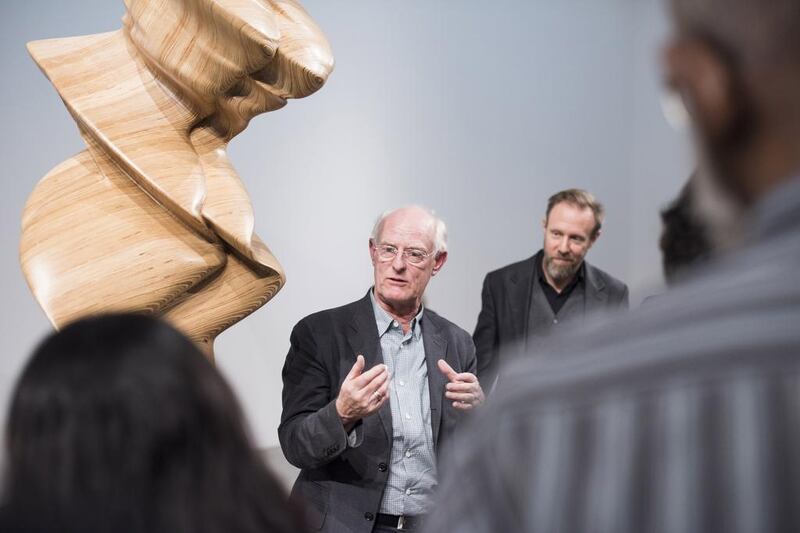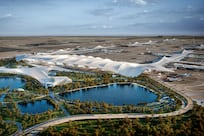When Tony Cragg won the Turner Prize in 1988, he was a controversial choice. Many believed the award should have gone to Lucian Freud, who was commended by the committee in the same year.
However, Cragg, now considered one of the world’s foremost sculptors, says the honour had little effect on his career – he even gave away the £10,000 (Dh46,358) prize money to charity.
At the time, he was noted for using recycled material, but this was only one aspect of a lifelong exploration of the nature of material of all kinds – something that manifests itself in his large sculptures, which mostly defy description. He creates objects and forms that do not exist, and for which we do not have words.
“My interest is not what things look like, but why they look like that,” he says. “I don’t want to represent something or reproduce something we are already familiar with. I want to be involved with the internal structure of the material.”
Conversations with Cragg about material are deeply philosophical and can spin off on fascinating tangents.
“How much of the reality that we see in front of us exists when we are not looking at it?” he asks, almost rhetorically, and then pauses to ponder.
“Human thought is a dimension in my opinion and my sculptures are the result of thought and experience with material.”
It is clear that Cragg thinks long and hard about any structure before building it. In that sense, his sculptures are not at all random or abstract, as many people might describe them.
Actually, he says, they are “not chaotic at all”. He creates mathematical systems and rules, which he then explores and follows until he reaches a form with which he is happy.
A Head, I Thought (2011) is a two-metre box-like sculpture, carved out of wood, and is both geometric and anamorphic. It has complex fluidity, but seems structured enough to be aesthetically pleasing, albeit for reasons that you might not quite be able to fathom. This is true with all his sculptures, 18 of which are on show at the Leila Heller Gallery in Dubai this month.
Hardliner (2013), made of bright-orange bronze, has an industrial feel, with both jagged and rounded edges. 3D Incident (2007) resembles a head, with a profile clearly visible from one side, but on the reverse, the bronze undulates like a wave of shiny black, which transforms the structure into something without a name.
This is, perhaps, a nod to the history of sculpture which, from the Renaissance until the end of the 19th century, was mostly concerned with reproducing the human form.
“This reduced sculpture to craftsmanship,” he says. “For me, it is not that exciting to copy things because nature made these things and made them so magnificently.
“What is so wonderful about making a head in marble when a head has several trillion neurons in it and is the most magnificent, complicated structure in the universe? Why would you then make it in marble? I don’t quite get that.
“I think there are other ways of expressing the complications and the sublime quality of the material.”
Cragg’s ongoing experimental approach to materials, and how he can elicit an emotional response from a viewer by creating new forms and new expressions with them, have paved the way for a long and successful career.
He left his native United Kingdom in 1977, settling in Wuppertal, western Germany, and began teaching at Kunstakademie Düsseldorf. After winning the Turner Prize, he represented the UK at the Venice Biennale, and had many high-profile exhibitions over the next two decades.
Notable venues on this long list include Centre Georges Pompidou, Paris, in 1996, London’s Royal Academy in 1999, and the Musée du Louvre in Paris in 2011.
Last year, his exhibition at the Hermitage museum in St Petersburg received critical acclaim, and next month, his biggest UK exhibition to date, will take place at the Yorkshire Sculpture Park.
In the Middle East, a touring exhibition is planned for three cities in Iran: Tehran, Isfahan and Yazd.
A chance to see Cragg’s work in the flesh, as it were, is extremely important, because the wonder of his artworks can only truly be appreciated this way.
When he speaks about his work, a word that continually comes up is emotion. He is clear that he is attempting to elicit an emotional reaction. “My works are absolutely geometric objects, but at the same time, they have a complicated enough form that you can get involved with them and have an emotional response. I think that is very significant,” he says.
This significance is mostly bound to the fact that most of us do not give much thought to reflecting upon our existence, he adds.
“One of the saddest things is that we don’t realise what an unimaginable miracle it is that we exist and that we can reflect upon that,” he says.
Perhaps, then, rather than trying to work out the meaning of a Tony Cragg sculpture, we should simply sit and meditate on what it means to be alive.
• Tony Cragg runs until March 6 at Leila Heller Gallery, Alserkal Avenue, Dubai. Visit www.leilahellergallery.com
aseaman@thenational.ae





